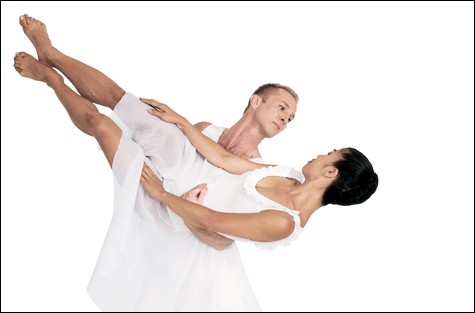
|
Dancers are working with character more frequently, after decades of choreography drenched in physical accomplishment. It’s another phase in a perennial campaign aimed at relating the dance to the audience. As if dancing by itself weren’t human enough. At Concord Academy Summer Stages last week, Headlong Dance Theater of Philadelphia took off from an Isaac Bashevis Singer novel, Shosha, about love and unworldly delusion in Poland during the rise of the Nazis.
The 50-minute dance retains the merest thread of a story about a naive young couple (Nichole Canuso and David Brick) who discover love, marry, and are parted by death. Two other women (Amy Smith and Niki Cousineau) tempt the boy with sensuous tangos, but after taking notes on their arch seductiveness, he returns to Shosha, trying by degrees to overcome her fear of intimacy.
Their relationship is framed — managed — by a vintage 1970s theater director (Andrew Simonet), who smirkingly explains the whole play to the audience with too-big gestures and fake geniality. He then turns to his willing actors. On this level of the performance, the characters are supposed to emerge from the kind of theater games and pseudo-psychological studio stuff that experimenters practiced in the heady days of the counterculture. Canuso and Brick are wrapped in some imposed tangle of limbs; Simonet stands back and scrutinizes them. After perfunctory reassurances (“Terrific, terrific”), he eggs them on (“Let’s think of it as very intimate, and personal? But project.”). The dancers look at each other intently, push themselves into a more crabbed and off-balance position.
The piece goes back and forth between Singer’s fictional characters and Headlong’s simulated improvisers, sometimes cutting abruptly to Simonet’s directorial interventions. After several tender duets, Canuso is dressed for her wedding, and Brick, perhaps at the end of his patience, throws himself on her in a brutal deflowering. “Okay, okay, stay,” says Simonet, launching into further encounter-speak.
As the two stand side by side, perhaps about to be married, Canuso turns to look at Brick, and, with a clap of thunder, he slips away. She slowly steps into a big trunk where he’d stored his books. She curls up and closes the lid. He comes and locks the trunk and drags it off. The little town of cardboard houses that she was building at the beginning of the piece blows away in a manufactured wind.
Five real men told their stories to Gideon Obarzanek, choreographer/director of the Australian company Chunky Move, which returned to Jacob’s Pillow two weeks ago. For a documentary, they talked about how they felt about dancing, and their revelations spun off into a staged version, supplying a verbal and video text for I Want To Dance Better at Parties. Five large screens hung at the back of the space in the Doris Duke Studio Theatre, each with a figure outlined on it. As each man told his story to the camera, a live dancer became his alter ego.
The subjects revealed a surprising amount about themselves in words. Two of the men had learned to love the folk dances of their immigrant parents. One guy liked going out with his gay clog-dance group. A widower discovered dance lessons as a way out of his loneliness. One man stubbornly couldn’t see himself dancing, ever.